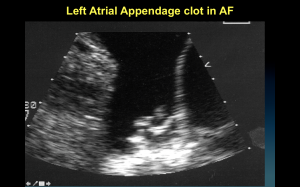When it comes to the risk of stroke in atrial fibrillation, it pays to be a boy. Sorry, ladies.
An important question came up on my recent post on AF and stroke.
Why does being female give you an automatic point on CHADS2-VASc? I keep seeing it, but I don’t see why that is.
It doesn’t seem intuitive that female AF patients should have more strokes. Why? AF should equal AF.
But it does matter. When it comes to AF and stroke, women are very different.
Here are three references that support the fact that female gender increases the risk of stroke in AF.
–First: This Italian study of 780 AF patients on blood-thinners, published in the British blood journal, Thrombosis Haemostasis, reported three main findings:
- Female gender did not increase the risk of bleeding.
- Female gender—even when correcting for age–doubled the risk of stroke.
- Females had more disabling strokes, including a three-fold greater risk of fatal stroke.
–Second: From the British Medical Journal (January 2011): This registry-based look-back Danish study of more than 70,000 AF patients between 1997-2006 showed that female gender alone increased the risk of stroke. Additionally, adding female gender with other moderate risk factors (high blood pressure, age > 65 and vascular disease) greatly accentuated stroke risk. It was a strong study due to the huge number of subjects.
–Third: The strongest study to date on gender-related differences in the risk of stroke in AF comes from the ATRIA study, published in 2005 in Circulation. Researchers form California and Boston looked back at more than 13,000 AF patients. They found that females had a 60% greater risk of stroke. The enhanced risk occurred at all ages and held up after correction for confounding diseases. Reassuringly, they also found that warfarin reduced stroke risk equally in females and males.
Data like this is why European AF specialists believe that female gender warrants a point on the CHA2DS2-VASc score.
AF patients and treating docs have to remember that stroke represents a devastating complication from AF. There exists many situations where one can live reasonably well with partially damaged organs; the brain is often not one of these. Sight, memory, speech, cognition, ambulation, and continence are all brain-controlled functions that directly relate to quality living. Stroke is to be avoided. And another thing to think about: though bleeding is a risk of blood thinners, bleeds rarely leave permanent damage. Bleeds can be treated and often are impermanent–unlike stroke.
Here are the pertinent risk factors for stroke:
C: Congestive Heart Failure (or a weak heart muscle; low ejection fraction)
H: High Blood pressure
A*: Age above 75
D: Diabetes
S*: Previous stroke or TIA (or clot)
V: Vascular disease (CAD, PAD, Aortic plaque)
A: Age between 65-74
Sc: Female gender
The data is clear; if one or more of these risk factors are present, the evidence strongly suggests thinning the blood with either warfarin or dabigatran protects one from stroke.
Hope this helps.
JMM
* – Represents very strong risks and warrant two points on the CHADS-VASc scoring system.
